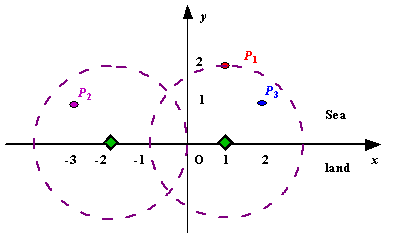Description
Assume the coasting is an infinite straight line. Land is in one side of coasting, sea in the other. Each small island is a point locating in the sea side. And any radar installation, locating on the coasting, can only cover d distance, so an island in the sea can be covered by a radius installation, if the distance between them is at most d.
We use Cartesian coordinate system, defining the coasting is the x-axis. The sea side is above x-axis, and the land side below. Given the position of each island in the sea, and given the distance of the coverage of the radar installation, your task is to write a program to find the minimal number of radar installations to cover all the islands. Note that the position of an island is represented by its x-y coordinates.

Figure A Sample Input of Radar Installations
We use Cartesian coordinate system, defining the coasting is the x-axis. The sea side is above x-axis, and the land side below. Given the position of each island in the sea, and given the distance of the coverage of the radar installation, your task is to write a program to find the minimal number of radar installations to cover all the islands. Note that the position of an island is represented by its x-y coordinates.

Figure A Sample Input of Radar Installations
Input
The input consists of several test cases. The first line of each case contains two integers n (1<=n<=1000) and d, where n is the number of islands in the sea and d is the distance of coverage of the radar installation. This is followed by n lines each containing two integers representing the coordinate of the position of each island. Then a blank line follows to separate the cases.
The input is terminated by a line containing pair of zeros
The input is terminated by a line containing pair of zeros
Output
For each test case output one line consisting of the test case number followed by the minimal number of radar installations needed. "-1" installation means no solution for that case.
Sample Input
3 2 1 2 -3 1 2 1 1 2 0 2 0 0
Sample Output
Case 1: 2 Case 2: 1
x轴以及其上方有一些海岛,要在x轴(海岸)上安装最少的雷达(每个雷达覆盖范围半径为d),使得每个海岛都能被雷达覆盖到,求安装的最少雷达的数量。
思路是,对于某个海岛i,求出海岸上最小的区间[ai,bi],s.t.任意的在这个区间内位置安装雷达都可以覆盖该岛
then对于每个海岛,都有一个区间[ai,bi](若求不出区间,显然是无论如何雷达都覆盖不到海岛了,就输出-1),这样就变成了区间选点问题。
#include<cstdio>
#include<cmath>
#include<algorithm>
using namespace std;
typedef struct{
float x;float y;
}type;
bool cmp(type a,type b)
{
if(a.y == b.y) return a.x > b.x;
return a.y < b.y;
}
type island[1003];
int main()
{
int n,d,kase=0;
bool flag;
while( scanf("%d %d",&n,&d) == 2 && n!=0){
flag=1;
for(int i=1;i<=n;i++){
scanf("%f %f",&island[i].x,&island[i].y);
if(island[i].y > d){
flag=0; //如果有某个海岛无论如何雷达都覆盖不到的话,就标记一个false
}
float x=island[i].x;
float delta=sqrt(d*d-island[i].y*island[i].y);
island[i].x = x - delta; island[i].y = x + delta; //将海岛的坐标转换为对应安放雷达的区间
}
if(flag==0){
printf("Case %d: -1\n",++kase);
continue;
}//如果前面有某个点标记了false,输出-1
sort(island+1,island+n+1,cmp); //将区间排序,为后续区间选安放雷达的点做准备
int i=1,cnt=1;
do{
float end_point = island[i].y;
int j;
for(j=i;;j++)
if(j == n || island[j].x > end_point) break; //寻找下一个点的位置(位于哪个区间)
if(island[i].y < island[j].x) cnt++; //如果找到的那个区间可以确实不能被上一个点覆盖到,就增加一个雷达点
i=j;
}while(i < n);
//区间选点完成
printf("Case %d: %d\n",++kase,cnt);
}
}
测试数据:
2 5
-3 4
-6 3
4 5
-5 3
-3 5
2 3
3 3
20 8
-20 7
-18 6
-5 8
-21 8
-15 7
-17 5
-1 5
-2 3
-9 6
1 2
2 3
3 4
4 5
5 6
6 7
7 8
8 7
9 6
10 5
0 0
2 3
0 2
2 3
2 3
0 2
1 3
3 3
1 2
-3 2
2 4
8 5
2 4
-4 4
-3 3
-3 1
-3 0
-1 0
0 5
6 0
3 0
1 2
-3 1
2 1
3 2
1 2
-3 1
2 1
1 2
0 2
2 3
0 2
2 3
4 -5
4 3
4 3
2 3
6 -9
3 -3
1 2
-3 2
2 1
6 2
1 2
1 2
1 2
-3 1
2 1
0 0
1 2
0 2
2 3
0 2
1 3
3 10
1 10
2 3
4 5
3 5
1 10
2 3
4 5
4 7
1 10
2 3
4 5
0 0
3 9
1 10
2 3
4 5
2 5
0 3
8 3
0 0Case 1: 1
Case 2: 2
Case 3: 4
Case 4: 1
Case 5: 1
Case 6: -1
Case 7: 3
Case 8: -1
Case 9: 2
Case 10: 1
Case 11: 1
Case 12: -1
Case 13: -1
Case 14: 2
Case 15: 1
Case 16: 1
Case 17: 1
Case 18: -1
Case 19: -1
Case 20: -1
Case 21: 1





















 520
520











 被折叠的 条评论
为什么被折叠?
被折叠的 条评论
为什么被折叠?








